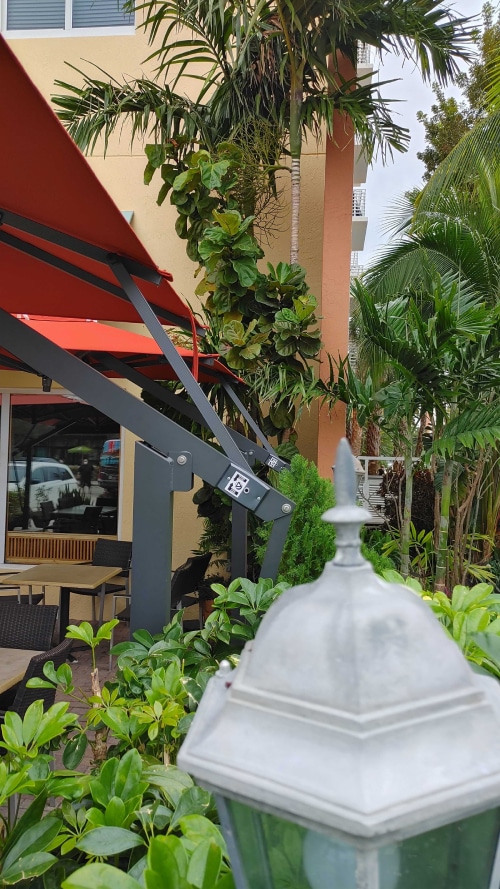Umbrella Stand: Weighted vs Fixed Base

Have you ever pondered the difference between a weighted vs fixed base for your umbrella? Perhaps you haven’t given it much thought seeing as Florida is one of the overall least windy states in the nation (despite being the most hurricane vulnerable). April is the windiest month, with an average wind speed of 8 knots (9.2 mph) which meteorologists consider “a gentle breeze”. That said, nothing ruins the vibe of an event more suddenly than a wayward umbrella!
 A weighted base umbrella stand is non-permanent, letting you move it around. It is a suitable option when:
A weighted base umbrella stand is non-permanent, letting you move it around. It is a suitable option when:
 An additional source of stability in windy spaces, wind bars snap into place to strengthen the frame of your umbrella.
Choosing the right base for your umbrella is crucial in ensuring that it is stable and erect in calm weather conditions and does not flip-flop or fly away on a windy day. Contact Poggesi USA for more information about the weighted vs fixed base debate.
An additional source of stability in windy spaces, wind bars snap into place to strengthen the frame of your umbrella.
Choosing the right base for your umbrella is crucial in ensuring that it is stable and erect in calm weather conditions and does not flip-flop or fly away on a windy day. Contact Poggesi USA for more information about the weighted vs fixed base debate.
Fixed Base Umbrella Stand
Fixed base umbrella stands are either in-ground or bolt down, both of which leave a clean finish and are excellent as the starting point of a project. In-ground bases are placed directly into a hole in the ground. A concrete footing is poured around a special in-ground fitting that connects to a spigot – creating a secure mount for your umbrella. A hinge on the side allows for easy removal of the umbrella. When the umbrella is removed, an optional walk-over cap covers and protects the adapter plate. Bolt down bases can be fixed to concrete slabs with a minimum depth of 4′ and a minimum screw fixing of 3′. If you want to install a bolt down base on a timber deck, there are ways to increase its stability and ensure structural integrity:- Reinforce the decking with additional timber joists to brace its structure.
- Run bolts through the joists.
- Use washers beneath the surface plate so that water can escape rather than pool and damage your deck.
Weighted Base Umbrella Stand
 A weighted base umbrella stand is non-permanent, letting you move it around. It is a suitable option when:
A weighted base umbrella stand is non-permanent, letting you move it around. It is a suitable option when:
- Your patio or outdoor seating area comprises several settings that you want to shade with one, movable umbrella.
- You need to relocate the umbrella as the sun moves during the day.
- A temporary solution is needed before you install a fixed base.
- You do not have permission to do a fixed installation, at a rental property, for example. Or at cafés and other al fresco eateries where organizing council permission may be costly and time-consuming.
- An in-ground base cannot be installed because of a sub-surface membrane. Waterproofing issues may be caused by umbrella installations on balconies or rooftop terraces.
How to Choose the Correct Stand
The style and size of your patio umbrella largely determines which kind of base is required. While center pole and cantilever umbrellas can use either weighted or fixed bases, the bigger the umbrella canopy and the windier the location, the more appropriate a permanent base is. Fixed installation bases provide a higher level of wind resistance , while mobile umbrella bases provide the flexibility of being able to move them from one spot to another.Using Wind Bars for Your Umbrella
 An additional source of stability in windy spaces, wind bars snap into place to strengthen the frame of your umbrella.
Choosing the right base for your umbrella is crucial in ensuring that it is stable and erect in calm weather conditions and does not flip-flop or fly away on a windy day. Contact Poggesi USA for more information about the weighted vs fixed base debate.
An additional source of stability in windy spaces, wind bars snap into place to strengthen the frame of your umbrella.
Choosing the right base for your umbrella is crucial in ensuring that it is stable and erect in calm weather conditions and does not flip-flop or fly away on a windy day. Contact Poggesi USA for more information about the weighted vs fixed base debate.